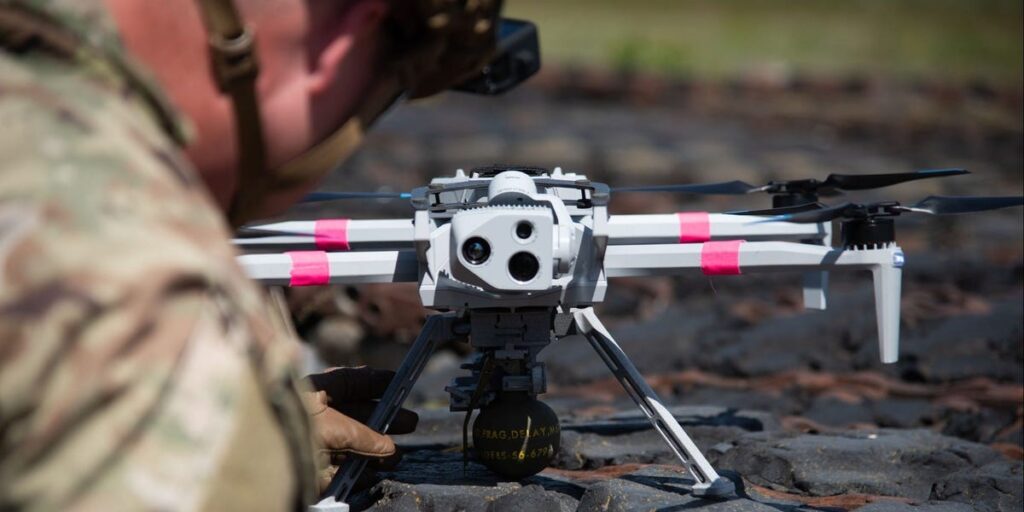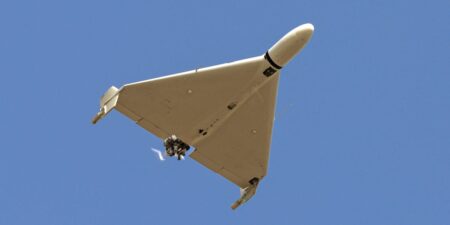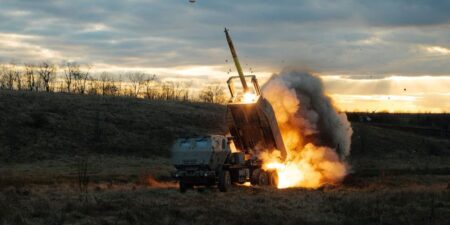A new video shows the US Army’s first test of a drone dropping a live grenade on a target.
Small drones have been dropping grenades in combat for years, but this way of war is new for the Army. There’s now a growing recognition that proficiency with small drones will likely be critical in future fights. Dropper drones like these are prolific in the Ukraine war, making brutal front-line fights even more horrific.
The new footage is the latest example of how the Army is training in uncrewed aerial systems and related capabilities, which have become a top priority for the force amid the Ukraine war and growing investments in drones.
On Monday, the Army offered a look into its first-ever drop of a live grenade from a small drone. The test took place during an exercise in Germany last month. A video shared by the Army on social media showed the recent testing, including operators attaching the grenades to the small quadcopters, flying the drones, and dropping the grenades on targets.
Soldiers from the 278th Armored Cavalry Regiment, 7th Army Training Command, 173rd Airborne Brigade and Joint Multinational Training Group-Ukraine armed a Skydio X10D drone with an M67 grenade, which it carried in flight before dropping the explosive on a wooden car-shaped target on a range. Other drones were also present to provide observation of the test.
Combat Capabilities Development Command’s new Audible dropper, which pulls the pin on the grenade and releases the weapon over the target, is attached to the main drone. The Army said that future training would involve 3D printing these at scale.
In a press release earlier this month, the Army said the initial field test would provide feedback for future training.
“While this is just an initial test of one capability, the lessons learned here have a rippling effect for informing global defense and building the Eastern Flank Deterrence Line,” said Brig. Gen. Steven Carpenter, commander of the 7th Army Training Command, referring to a NATO initiative to strengthen the alliance’s eastern defenses.
While the test marks a development in the Army’s capabilities, other militaries and non-state actors have been dropping grenades and munitions from small drones for years.
In the mid-2010s, US and Iraqi forces began documenting ISIS using commercial quadcopters and fixed-wing drones to carry small munitions, such as grenades.
In Russia’s war against Ukraine, Kyiv’s troops have used drones to drop munitions and grenades on Russian tanks, vehicles, soldiers, and ammunition storage. Ukraine has also packed explosives into its first-person-view drones and flown them directly into targets.
Russia, too, has used flying drones over Ukrainian targets and dropped explosives. Many of Ukraine and Russia’s drones, ranging in models and sizes, can carry different ordnance to either release above or fly directly into targets as one-way attack assets.
The US military has been signaling an increased interest in investing in uncrewed capabilities for years, but there’s a growing push now for small drones. In a recent memo, US Secretary of Defense Pete Hegseth directed the Army to heavily invest in drones, planning to arm every division with 1,000 of them within the next two years. And last week, following President Donald Trump’s call for American drone dominance, Hegseth shared new plans to boost the Pentagon’s drone arsenal.
US soldiers have also been training with small drones in environments like the Indo-Pacific, testing how to use the systems as both weapons and reconnaissance and surveillance platforms. These are being increasingly looked at across the force, as are counter-drone capabilities to kill enemy systems.
Read the full article here
















